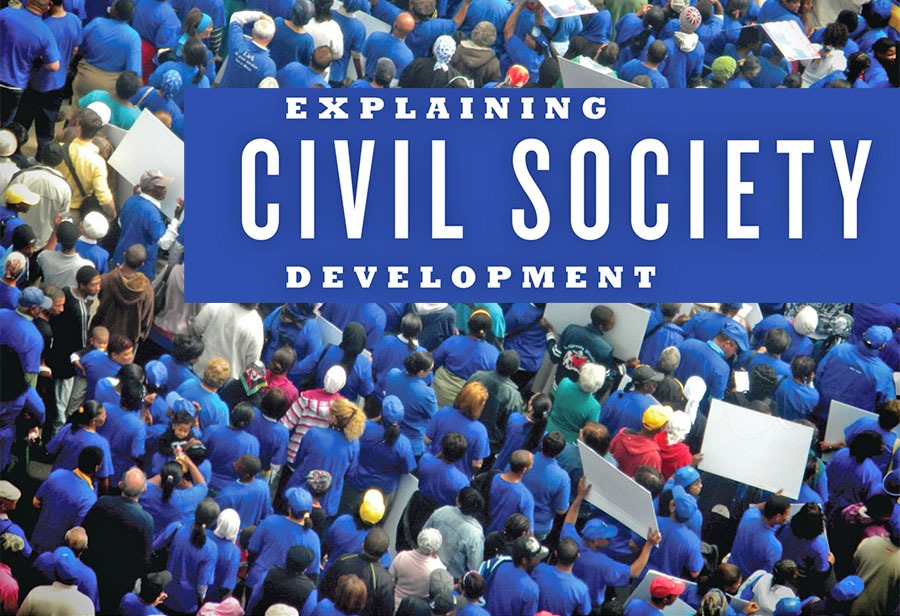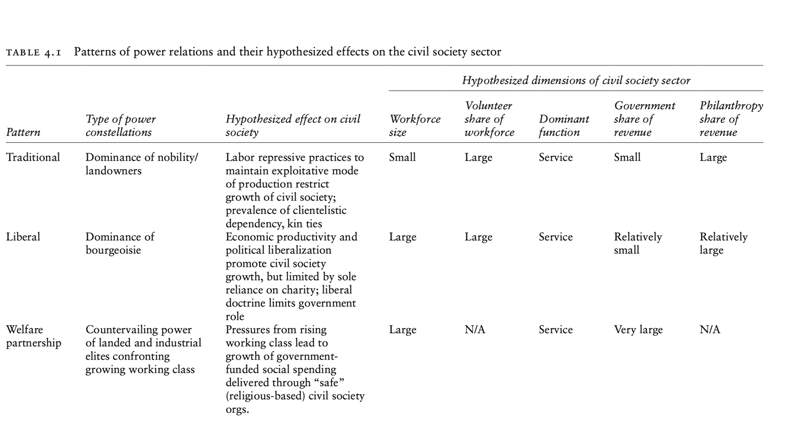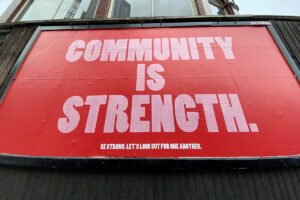
An excerpt from Explaining Civil Society Development: A Social Origins Approach, by Lester M. Salamon, S. Wojciech Sokolowski, Megan A. Haddock, and Associates, reprinted with permission from Johns Hopkins University Press.
Chapter 4
[T]he search for explicative laws in natural facts proceeds in a torturous fashion. In the face of some inexplicable facts you must try to imagine many general laws, whose connection with your facts escapes you. Then suddenly, in the unexpected connection of a result, a specific situation, and one of those laws, you perceive a line of reasoning that seems more convincing than the others.… But until you reach the end you never know which predicates to introduce into your reasoning and which to omit.
—Umberto Eco, The Name of the Rose, 366
Introduction: Bringing Power In
In the preceding chapter we examined several theories attempting to explain the cross-national variations in the dimensions of the civil society sector that have emerged from our empirical work and found them largely inadequate to the task. We suggested that a major reason for this may be that these theories are “undersocialized,” that is, that they take too little account of the macrosocial conditions that constrain or shape choices regardless of individual preferences or the most efficient means of their attainment.
In point of fact, choices about whether to rely on the market, the civil society sector, the state, or kinship networks in the provision of key human services are not simply made freely by individual consumers or service providers adhering to norms of altruism or operating in an open market and perfectly functioning democratic political system, as the preference and sentiment theories seem to imply. Rather, research into human behavior has shown that such choices are heavily constrained by existing social, economic, and political structures resting on foundations inherited from the past and shaped by complex interrelationships among social strata and social institutions.1 These outcomes are therefore heavily affected not simply by sentiments and preferences but also by the exercise of political, social, and economic power. In other words, the warm, fuzzy world of charity and civil society activity is hardly immune from the fundamental insight of Anthony Giddens that “[p]ower is to social science what energy is to thermodynamics.”2 It determines whether there is movement and, if so, in which direction. Against the backdrop of this discussion of sentiments and preferences we therefore turn in this chapter to an alternative body of explanation that brings power full-square into the story.
But what aspects and forms of power are most likely to be involved? Fortunately, as mentioned in the introduction, we are not completely at sea in identifying some likely suspects. Rather, scholars who have grappled with the intriguing and complex question of what accounts for different historical patterns of social, political, and economic development have provided us with a number of promising clues about the factors that might be involved and the outcomes likely to result. Three strands of such theorizing in particular seem most relevant.
In this chapter we first review these three alternative strands of theorizing and then lay out the implications they hold for the development of an alternative “social origins theory” of civil society development and for the patterns of civil society development it brings into view.
Three Promising Strands of Theorizing
SOCIAL ORIGINS THEORY AND ECONOMIC CLASS RELATIONSHIPS
Perhaps the most persuasive of these strands of theory is the one associated with the work of Barrington Moore, Jr., a Harvard sociologist whose book Social Origins of Dictatorship and Democracy has significantly reshaped thinking about the factors responsible for what Moore identified as three distinct “routes to the modern world”—democratic, fascist, and communist.3 The key drivers of these alternative routes, Moore argues, are the different patterns of socioeconomic class relationships that exist in different societies during the critical period of industrial development. Unlike conventional Marxian analyses of class relationships, however, Moore extends his analytical focus to class relationships in the rural countryside, subtitling his book “Lord and Peasant in the Making of the Modern World” to underline the point.
In Moore’s analysis, whether countries evolve into democracies, fascist states, or communist dictatorships—or wallow in poverty—depends fundamentally on the particular constellations of relationships that emerge among landed elites, the rural peasantry, urban workers, commercial and industrial middle-class elements, and the state. Where landed elites establish exploitative forms of agriculture requiring repressive systems of labor control and the governmental apparatus to enforce them, the prospects for the growth of a market economy and democratic political institutions are limited. Depending on other circumstances, two other outcomes are more likely. The first is “a revolution from above” leading to authoritarian and militaristic regimes. This occurs if modernizing elites in the state administration or the military react to foreign threats or pressures from below by abolishing the old order and the landed elites supporting it and establishing modernizing, but still authoritarian, regimes to push through programs of rapid industrialization. Such developments occurred, according to Moore, in Germany, Japan, and, according to subsequent scholarship, also in Turkey, Egypt, and Peru.4 The alternative, Moore argues, is prolonged economic stagnation that either persists, as in India, or, under the proper circumstances, triggers a communist revolution, as in China.
For democracy to emerge, Moore suggests, the hold of landed elites and labor-repressive agriculture has to be broken, the “peasant problem” solved, urban commercial and industrial elements strengthened, and some reasonable balance established between the working classes and these middle-class elements.5 This can occur through revolution, as in 18th-century France; through the conversion of landed elites into capitalist farmers through a shift to export-oriented agriculture, as in England; or in a variety of different ways. But the basic shift in class relationships remains the same regardless of the form through which it is achieved.
BRINGING IN THE POLITICAL
This central, and almost exclusive, role of socioeconomic class in the social origins explanation of different paths to the modern world has, in turn, stimulated a second line of theorizing that takes the class-based analysis to task for paying insufficient attention to political institutions, including the state and political parties. Thus, Evans et al. argue that class-centered, or macroeconomic, explanations of political outcomes are incomplete without considering the role played by the state, which they argue has considerable, albeit varying, autonomy from class and other interest group pressures.6 Dietrich Rueschemeyer et al. develop this line of argument more fully by combining the analysis of class relationships à la Moore with an analysis of the impact of political institutions, particularly political parties and transnational state relations, on political and economic outcomes.7 Focusing on a wide range of European and Latin American countries, this group of analysts points to strong political party systems as crucial factors in the emergence of democracy in a number of Latin American countries, since such systems made it possible to mediate and moderate conflicting class interests between traditionally dominant landed elements and the emergent urban middle class that grew to prominence through Latin America’s expanding export-oriented economy.8 A similar line of argument can be found in Skocpol’s explanation of different welfare policy outcomes in the United States and Western Europe, though here more emphasis is placed on the structure of government itself.9 In the United States, she argues, a fragmented governmental structure, a relatively weak federal bureaucracy, and intensive competition between major political parties that often relied on patronage to mobilize popular support, coupled with strong women’s civil society organizations, led to the implementation of decentralized social policies limited to targeting narrowly defined constituent groups (such as war veterans or working women). In Europe, by contrast, the much stronger role of the central government was a key factor, in addition to pressures from organized labor, in the implementation of universal, state-funded social welfare policies.
ALTERNATIVE WELFARE REGIMES
A third line of theorizing of potential assistance in our search for explanations of the observed variations in civil society characteristics around the world emerges from research into post–World War II government social welfare policies. This research has led to the conceptualization of various distinctive patterns of welfare regimes. Richard Titmuss, for example, offers a tripartite classification of such regimes, which he characterizes as “residual,” offering minimal social assistance consistent with traditional liberal ideology; “institutional,” striving to assure adequate living conditions to the entire population; and “industrial-achievement,” providing benefits conditioned on employment status and earnings.10 Gøsta Esping-Andersen introduces another classification, characterizing different welfare state regimes as “liberal,” or minimalist; “corporatist,” or responding to a wide assortment of engaged institutional actors; and “social democratic,” or universalistic and rights-based.11
Putting It All Together: An Expanded Social Origins Theory of Civil Society Development
Although these various theoretical frameworks go to great lengths to explain the role of power relations in shaping modern institutions, they tend to view the civil society sector, at best, as a tangential independent variable that helps to explain broader political outcomes (e.g., the formation of political parties and the consequent structuring of political institutions) while paying less attention to the factors that shape the civil society sector itself. Indeed, one of the striking realities of the welfare state literature is its virtual disregard and neglect of the civil society sector, even though the welfare state in many of its classic European incarnations really took the form of a “welfare partnership” instead, as the data reported in chapter 2 made clear.
To what extent, therefore, can these theoretical frameworks help us explain the presence, shape, and role of the civil society sector itself? Our argument here is that they are enormously helpful, that the same factors that have been used to explain the appearance of democracy, fascism, communist revolutions, persistent underdevelopment, and diverse welfare regimes can provide powerful insights into the central research question guiding this book—namely, what explains the tremendous variations in the size and contours of the civil society sector in different countries? The theoretical approach we propose here draws most fundamentally on Barrington Moore’s insight by arguing that these variations, and the patterns to which they give rise, can be traced ultimately to different power arrangements among key socioeconomic classes during critical turning points in national development. For this reason we call our approach the “social origins of civil society,” or SOCS, theory.
Our methodological approach to building and testing the social origins theory of civil society involves the following three steps. First, we outline the causal model that identifies the social forces that we suggest are likely to shape the dimensions of civil society. Second, we identify different configurations or patterns of these social forces and develop hypotheses that link these configurations to different constellations of civil society outcomes. Finally, we test these hypotheses against the available data. In the present chapter we take up the first two of these steps. Then, in chapter 5, we present the tests.
COMPONENTS OF A CAUSAL MODEL OF CIVIL SOCIETY DEVELOPMENT
The key contention of the SOCS theory is that the dimensions of the civil society sector are shaped by power relations among different social groupings and institutions. But what are those social groupings and institutions? To answer this question we make extensive use of the well-known social science concept of socioeconomic class, but in its Weberian manifestation more than in its Marxist one. Like Weber, we treat a socioeconomic class as a group of people who not only have a similar relation to economic resources (such as similar roles played in the production of economic outputs) but also occupy a similar social position or status.12 These socioeconomic classes, their various components or “fractions,”13 and various organizations affiliated with them are defined here as social actors. As such, they possess two important attributes—a certain level of common interests, whether clearly recognized and articulated or not, and a certain capacity to act on these interests. One measure of that capacity to act is the collective power of a social actor, that is, the capacity to prevail when confronted by opposing efforts of other social actors.14
The types of socioeconomic classes that exist in a society depend on the types of economic activities that prevail in that society, which, in turn, depend on the level of economic development. In premodern societies where agriculture is the dominant form of economic activity, the main socioeconomic classes include the nobility and landowning classes; the agrarian laboring classes that, depending on the geopolitical context, take the form of free peasants, serfs, or slaves; the intermediate classes consisting of small numbers of craftsmen, merchants, and professionals; the state, including ruling figures (e.g., monarchs), office holders, and the military; kinship groups, such as tribes, clans, or extended families; and organized religion, including priests, clerics, preachers, monks, and so on. In modern times, where industry is the dominant form of economic activity, some of these premodern classes lose power or disappear while new socioeconomic classes emerge, often in complex and interconnected forms. In necessarily simplified form, the resulting new class composition includes owners of capital and industrial establishments (the bourgeoisie), factory and farm workers (the working class), skilled professionals (doctors, lawyers, engineers, teachers, etc.), semiprofessional occupations (technicians, office employees, etc.), the self-employed (small shopkeepers, craftsmen, artists, etc.), and professionalized civil servant and military elements.
Although we see in social class power an important driver of civil society development, we also recognize that power is not automatic. To Moore’s emphasis on social class power we therefore add a second element in the form of Rueschemeyer et al.’s and Skocpol’s emphasis on a set of essentially political factors that determine how effectively various social classes actually take advantage of their potentials. The power of social actors depends, in other words, on several factors beyond the sheer numbers or economic weight of the social grouping. Also important are a variety of factors that can amplify, or alternatively filter and reduce, social class power and influence. Such factors can include the extent to which the class is conscious of its common interests, is mobilized and organized to advance those interests, has effective leadership, has links to potential allies, wraps its positions in culturally effective messages, and is not internally divided along racial, religious, or ethnic lines. The presence or absence of these various factors can enhance a class’s relative position or limit the ability of the class to play its potential historical role.
Also, like Skocpol and Rueschemeyer et al., we acknowledge that government is itself a key social actor. Contrary to the conventional Marxist analysis that views government mainly as the “executive committee” of the dominant socioeconomic class, the institutions of government can play their own significant role in shaping power relations in society. However, government is not a single actor but an assembly of different actors—including different branches (legislative, executive, and judiciary), different departments, law enforcement (the police), the military, and the political parties—sometimes acting in coordination and sometimes acting independently or even against each other. These different government actors may represent diverse interest groups in society as well as the interests of their own members. For that reason, we consider government to be a separate social actor rather than a mere representative of other socioeconomic classes.
In calling attention to the important impact that socioeconomic classes and the organizations and agencies that represent or oppose their interests have on the development of the civil society sector, we do not suggest that these actors operate in a social vacuum. Rather, we recognize that they are embedded in the rich fabric of social norms, cultural values, religious beliefs, and ideologies. The relationship between social groupings and these cultural values is interactive, however. On the one hand, the norms and values can constrain even powerful social groupings. At the same time, whether particular values or norms gain support or legitimacy can be influenced by their consistency with group interests. Max Weber recognized this latter point in his concept of “elective affinity,” the tendency of social actors to lean toward cultural norms and values that align with their predispositions and group interests.15 Thus, according to Weber, Protestant religious doctrines emerging in 15th- and 16th-century Europe gained ground in important part because they were more aligned with the economic interests of wealthy merchants than the traditional Catholic teaching renouncing worldly possessions.
Sign up for our free newsletters
Subscribe to NPQ's newsletters to have our top stories delivered directly to your inbox.
By signing up, you agree to our privacy policy and terms of use, and to receive messages from NPQ and our partners.
Although the importance of social values and cultural beliefs was emphasized by the sentiment theories discussed in chapter 3, these theories treated them as free-floating influences without observable causal links to particular social groupings or specific institutional outcomes. By contrast, the theoretical model proposed here acknowledges these causal links. Thus, the long-standing Catholic doctrine of subsidiarity, holding that social issues ought to be addressed by the social unit closest to the family, including, of course, the parish, provided a convenient template for conservative elements to use in resisting worker pressures for expanded state-provided social welfare protections in 19th-century Germany and ultimately led to channeling what protections were provided through safe, religiously affiliated, nonprofit organizations. Hence was borne a pattern we will later term “welfare partnership.”
From the third strand of theory introduced above, that reflected in the work of Esping-Andersen and other theorists of the welfare state, as well as from Moore, we take the important additional insight that the resulting relationships produce outcomes that are not scattered or random. Rather, they are patterned. They produce characteristic constellations of features that Esping-Andersen terms “regimes” and that we will refer to as characteristic “patterns” of civil society development.
Finally, throughout all three of these prior strands of theory runs another important insight that also figures prominently in our SOCS theory: that the patterns formed by the power relations among these social classes as they work themselves out during critical turning points in societal development persist over extended periods, even though the forces that initially produce them may no longer be in existence. The mechanism responsible for this persistence is referred to in social and economic literature as “path dependence.” Path dependence is observed in a wide range of social and economic phenomena, from geographical concentrations of industry,16 through trajectories of economic development,17 to political reforms and systemic transitions.18 Path dependence results from the fact that once certain institutional arrangements are put in place, it is easier and less expensive to expand on these arrangements than to create entirely new arrangements from scratch.19
In short, as depicted in figure 4.1 [below], our social origins theory of civil society development holds that power relationships among identifiable social classes and actors, mediated by a variety of power amplifiers and filters, stamp onto societies distinguishable patterns of civil society development that persist over extended periods.

IDENTIFIABLE CONFIGURATIONS OF POWER RELATIONSHIPS AND THEIR HYPOTHESIZED EFFECTS ON CIVIL SOCIETY
But what types of such configurations are possible, and what constellations of social actors, amplifiers, or filters are responsible for them? To answer this question, we begin with the observation that, although the types and number of socioeconomic classes in a country vary from one period or geographic region to another, it is possible, at least for analytic purposes, to group them crudely, using a concept known as “structural equivalence,” into three broadly defined categories defined by the relative power and social positions of the classes that occupy them: the high-, intermediate-, and low-status classes.20 Depending on historical circumstances, different social groupings may fit into each of these three structurally equivalent categories, though historically certain patterns have been most common. The high-status group has thus tended to be populated by the nobility and landowning classes, by commercial or industrial elites, or by both. The intermediate level has most commonly been occupied by craftsmen and merchants, skilled professionals, the professional military, or government officials. Finally, the low-status group has long been occupied by agrarian laboring classes, landless rural masses, factory workers, or service workers.
At various points in time, however, these roles and relationships can shift significantly, and it is these shifts that we suggest affect the size, shape, and contours of the civil society sector, often for long after the shifts occur. For heuristic purposes, however, it is possible to discern three broad configurations of power relations among these structurally equivalent status groups. In the first configuration, which we term “hegemonic,” the high-status groups exercise virtually absolute dominance over all other groups. In the second configuration, which we term “contested dominance,” the power of the high-status group is to some degree challenged by lower-status groups. Finally, in the third possible configuration, which we term “pluralism,” power is dispersed among high-, intermediate-, and low-status groups. Of course, there are possible variations within each configuration caused by historical, social, economic, and political circumstances, but the main insight suggested by this framework is that power relations among socioeconomic classes in different countries fall into a relatively small number of patterns, and those patterns of power relations, in turn, can result in a correspondingly constrained set of patterns of civil society sector development.
More specifically, based on this classification and the insights of Moore, Rueschemeyer et al., and Esping-Andersen, it is possible to postulate at least five types of social class power relationships, which vary according to which social class and social actors, or combination of these, holds dominant power in a society. The SOCS theory associates each of these social class power relationships with a likely pattern of civil society characteristics. As summarized in table 4.1 [below], the particular civil society characteristics that are driven by these different social class power relationships vary somewhat, so that it is necessary to distinguish between the defining features of a particular civil society pattern and the potentially variable ones. Thus, for example, discussed in the rough order in which they appear historically, what we term the “Traditional Pattern” of civil society is associated with what was once the most prevalent social class power arrangement in world history. This relationship is characterized by the dominance of the nobility and landed elites, who exercise hegemonic influence over the social, economic, and political life of a society or country. This hegemonic position is necessary to sustain an essentially exploitative mode of mostly agrarian production, which requires a variety of labor-repressive measures and strong clientelistic relationships. In this environment, the emergence of any form of organization of the subaltern social groupings faces serious obstacles because it poses a threat to elite hegemony. Therefore, the traditional pattern of civil society projected to emerge in this circumstance is small in scale, oriented to service functions, supported largely by the paternalistic charity of the dominant classes, and not uncommonly used by the landed or other economic elites to reinforce patterns of dependence. This is the pattern that Putnam describes so vividly operating in the south of Italy in the 14th century—curtailing the liberties of large segments of society and severely restricting the development of a meaningful civil society sector for literally centuries thereafter.21 Indeed, one keen observer found the basic circumstances intact five centuries later, depicting the social relations of Sicily as of 1876 as follows: “Every local notable in his jurisdiction of power was the head of a network of persons of the most diverse social conditions, who depended on him for their economic survival and social prestige and who furnished him legal support in terms of electoral suffrage and illegal support in the recourse to violence in defense of his particular interests, in a rigorously hierarchical relationship of para-feudal dependence.”22


Durable as this traditional pattern has proved to be in many places, however, it is vulnerable to both economic and ideological shifts, particularly since, as Acemoglu and Robinson demonstrate, it is associated with extreme inequality, overall poor economic performance, and widespread poverty.23 As other social classes gain power and influence, they can challenge the hegemony of landed interests and seek political and economic changes. This occurred, for example, in England beginning in the 17th century as the growth of commerce fueled the emergence of a wealthy class of merchants and industrialists who sought relief from the restrictions of feudal privilege and of landed dominance and who fortuitously benefited from the shift in the agriculture sector toward an export-oriented product (wool) that eliminated the need for a large and dependent rural peasantry and prompted the enclosure movement that rid the countryside of surplus labor. Armed with new liberal economic ideas calling for limits on big government and Protestant social values privileging thrift and blaming the poor for their indigence, these new elites looked to free enterprise in the economic sphere and reliance on private charity in the social sphere as their goal. We hypothesize that these developments give rise to a distinct “Liberal Pattern” of civil society development characterized by the emergence of various professional organizations but, in a climate of liberal hostility to government spending and long-standing traditions of deference by lower-status groups to privileged elites, an otherwise constrained civil society sector depending heavily on upper- and middle-class generosity to minimize the extremes of social distress while otherwise holding firm to principles of individual responsibility.
A third pattern emerges where industrialization and the partial liberalization of social relations leads to the substantial growth of a working class and of organizations representing its interests, but not to the point of displacing the dominant position of landed, industrial, or commercial elites. Confronted with stronger pressures from organized workers than those characteristic of circumstances that give rise to the liberal pattern, social elites in this situation face a number of options. One of the most common is to reduce the pressure by taking steps to splinter the working class elements along religious, ethnic, or racial lines. The effort to wean workers away from socialist-oriented unions and parties by establishing safer Catholic-oriented such entities in late-19th-century Europe is one illustration of this tactic.24 But another reaction, typified by the social welfare innovations of Chancellor Otto von Bismarck in late-19th-century Germany, is to buy off worker protest with state-sponsored social welfare protections—but channel these protections through “safe,” religiously affiliated, private voluntary organizations. We hypothesize that this produces its own characteristic pattern of civil society development, which we characterize as the “Welfare Partnership” pattern. This pattern leads to a substantial civil society sector, mostly focused on service activities instead of protest and advocacy, heavily subsidized by the state but safely held in check by conservative religious or other institutions.
Yet a fourth pattern can occur where the power of landed elites is weakened, whether by war, internal conflicts, or other factors, opening the way to industrialization and the emergence of a more pluralistic configuration of power relations engaging new professional and commercial elites and an energized and sizable working class. Where these latter lower-class elements remain unified and able to exert substantial influence on their own behalf, or with the aid of civil servants mobilized by concerns about social distress, we hypothesize the possibility of another distinctive pattern of civil society development, which we term the “Social Democratic Pattern.” Unlike under the welfare partnership model, where services are delivered through conservatively oriented religious charities that can co-opt and mute worker protest, in this social democratic pattern social welfare services are treated as a right of all citizens—not a gift bestowed by charitable institutions—and are delivered directly by governmental institutions subject to popular control by citizens. Worker political power, in this pattern, promotes an open political system with considerable freedom to form civil society organizations, but these organizations function mostly in expressive fields—arts, culture, recreation, sports, and advocacy for rights—and draw heavily on volunteers rather than paid staff.
A fifth constellation of social class and social actor power relationships arises where premodern landed elements retain power into the modern era and prolong economic stagnation that threatens the country’s sovereignty and national pride. In such settings, intermediate elements consisting often of military leaders, senior civil servants, urban professionals, or modernizing revolutionaries—fearing threats from more economically developed powers or mobilized by radical modernizing ideologies—take over state institutions in order to push through programs of rapid industrialization and modernization. Nineteenth-century Japan offers an example of this pattern when an offshoot of the country’s samurai warrior caste, embarrassed by the forced entry of the US navy in the 1850s, joined with some political leaders to seize power through what was known as the Meiji Restoration, disrupted the power of the feudal lords, and pursued rapid industrialization, militarization, and ultimately a war for control of natural resources. Early-20th-century Russia provides another example, though here it was an ideological clique that managed to seize control in a moment of war-induced weakness of both the military and traditional elites.
To keep popular forces at bay and make it possible to channel whatever surplus is produced into modernization rather than consumption, such modernizing elites often find it necessary to limit personal freedoms and particularly restrict the growth of civil society organizations that could challenge governmental dominance and disrupt the rapid modernization agenda through demands for greater political voice and better living standards. The hypothesized result is thus a “Statist Pattern” of civil society development characterized by a fairly small nonprofit sector, with little volunteer engagement, operating in a narrow range of essentially service fields.
Conclusion
In short, the SOCS theory argues that it is possible to discern in the historical record of recent human history at least five different constellations of social class and actor relationships, each associated with a particular, hypothesized pattern of civil society development characterized by a particular set of defining features. These constellations and their associated civil society patterns either took shape during the process of modernization and have largely survived into recent times due to the phenomenon of path dependence or were fixed in premodern times in societies where modernization has been largely delayed, except in narrow oases of urban modernity.
To be sure, these five constellations are ideal types, and particular details may differ, as suggested by the concept of structural equivalence. But the key thrust of the social origins theory is that the shape of the civil society sector in a society can be predicted, with more or less precision, from the constellation of social class and actor power relationships that the society exhibits. The test of this theory is thus the extent to which these predictions can be verified in the empirical record. To do so, such a test must address three interrelated questions:
- First, can the five hypothesized patterns of civil society development suggested here be observed in the actual empirical data we have assembled, and, if so, how extensively visible are they?
- Second, if they can be observed, can the hypothesized causes of these patterns—the five constellations of power relations as mediated by the identified filters and amplifiers—be found to be operating as hypothesized in the countries falling into the various patterns?
- Finally, can the SOCS theory also explain any countries that do not fit any of the patterns identified and therefore demonstrate its capacity to make sense of the inevitable shifts in underlying social and economic realities?
It is to these questions that we turn in the next chapter.
Copyright
Salamon, Lester M., S. Wojciech Sokolowski, Megan A. Haddock, and Associates. Explaining Civil Society Development: A Social Origins Approach. pp. 74-91. © 2017 Lester M. Salamon. Reprinted with permission of Johns Hopkins University Press.
Notes
- Zukin and DiMaggio 1990b.
- Giddens 1987, 7, 17.
- Moore 1966.
- Timberger 1978.
- Brenner (1982) brings a similar line of argument to explain differences in the institutional development of continental Europe and England, arguing that these differences can be traced to different power relations between the landed gentry and the peasantry in the Middle Ages. These power relations made it necessary for landed elements to rely heavily on the state to control the peasantry in Europe, whereas English landlords utilized market-type relationships to advance their interests instead.
- Evans, Rueschemeyer, and Skocpol 1985.
- Rueschemeyer, Stephens, and Stephens 1992.
- Ibid.
- Skocpol 1995.
- Titmuss 1974.
- Esping-Andersen 1990.
- For a discussion of Max Weber’s conception of social class, see Collins 1986, 125–130.
- The term “class fraction” has been introduced by Bourdieu (1984) to refer to socially distinct segments of a socioeconomic class identified primarily by social and cultural characteristics.
- Giddens 1987.
- Weber 1958. See also Howe 1978.
- Krugman 1991.
- Gerschenkron 1992.
- Hausner, Jessop, and Nielsen 1995.
- A good illustration of path dependence is the persistence of the imperial measuring system in the United States, whereas almost all other countries adopted the metric system. The imperial system was the basis for the development of measurement standards when the industrial revolution in the United States took off, and changing these standards to the metric at a later time proved too difficult politically and economically.
- The concept of structural equivalence, used widely in analyses of social structure, refers to the fact that different individuals or groups may play similar roles or occupy similar positions in different social arrangements. For more detail, see Sailer 1978.
- Putnam 1993, 121–134.
- Quoted in Putnam 1993, 145.
- Acemoglu and Robinson 2012.
- See, for example, the 1891 encyclical Rerum Novarum, which warned Catholic workers to be wary of trade unions that “are in the hands of secret leaders, and are managed on principles ill-according with Christianity and the public well-being; and that they do their utmost to get within their grasp the whole field of labor, and force working men either to join them or to starve. Under these circumstances,” Pope Leo XIII advised, “Christian working men must…form associations among themselves and unite their forces so as to shake off courageously the yoke of so unrighteous and intolerable an oppression” (Pope Leo XIII 1891, para. 54).











